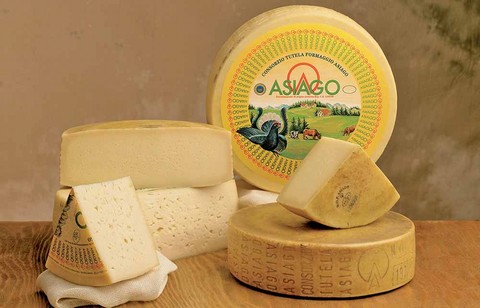
Si tratta di uno tra i più conosciuti prodotti veneti e prende il suo nome dall'Altopiano di Asiago. Già nell'alto Medioevo, sembra vi si producesse un gustoso formaggio ricavato dal latte delle pecore. Nel corso degli ultimi secoli, con il miglioramento di prati e pascoli, l'allevamento ovino lasciò lentamente posto a quello bovino ed il latte vaccino divenne la base su cui applicare l'antica esperienza, dando luogo alla moderna tecnica casearia che ancora oggi si pratica nelle malghe dell'Altopiano.
Attualmente la zona di raccolta del latte e di produzione del formaggio Asiago D.O.P., comprende l'intero territorio delle province di Vicenza e Trento e una parte delle province di Treviso e Padova.
L'Asiago più vicino all'austera tradizione dei casari altopianesi è certamente quello d'allevo, le cui forme vengono tagliate solo dopo mesi di stagionatura. È un formaggio da tavola che diventa mezzano dopo 4-6 mesi, vecchio con stagionatura superiore ai 10 mesi e stravecchio se stagionato oltre i 15 mesi. Il sapore è dolce e la pasta è compatta nel formaggio mezzano, mentre il tipo vecchio o stravecchio è più saporito e leggermente piccante e la pasta è più dura e granulosa.
Negli anni '20 è iniziata la produzione di un formaggio Asiago a più breve stagionatura, chiamato pressato poiché le forme appena prodotte vengono sottoposte ad una pressatura sotto torchi manuali o idraulici. L'Asiago pressato è un formaggio da tavola e con sapore tendente al dolce.